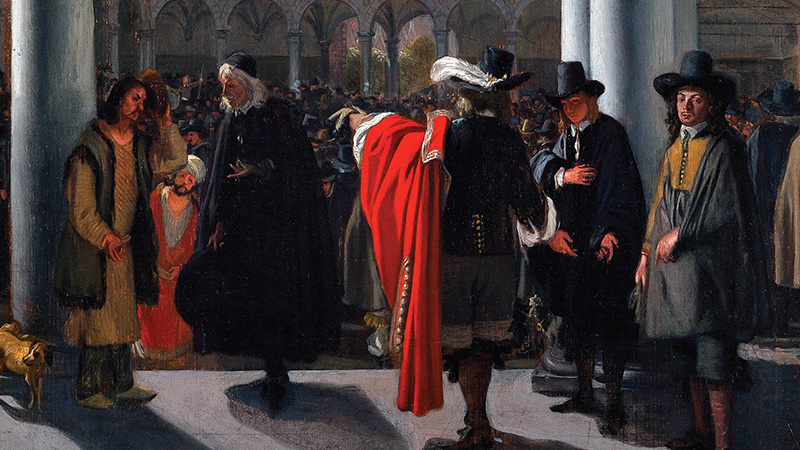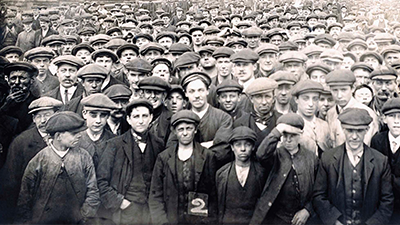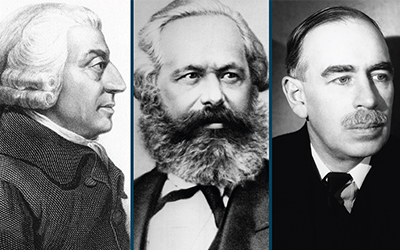Capitalism and Socialism
Teacher Resources
Driving Question: How did industrialization reshape economic systems, and what were its impacts?
Capitalism created new wealth and new struggles. Competing economic ideas offered different answers to the question of who should benefit from labor, and why it matters.
Learning Objectives:
- Learn about the economic theories of capitalism and socialism in the context of the Industrial Revolution.
- Use close-reading skills to draw comparisons between the principles and practices of economic systems.
- Practice making claims and counterclaims using evidence from multiple sources.
Vocab Terms:
- capitalism
- consumer
- industrial capitalism
- joint-stock company
- proletariat
- social class
- socialism
Opener: Capitalism and Socialism
To teach this lesson step, refer to page 2 of the Lesson 4.2 Teaching Guide.
The Industrial Revolution upended the organization of human communities, but some things remained consistent. Compare the social pyramids of medieval and industrial society to see what changed.
Pyramids of Capitalism
Transformations of Capitalism
To teach this lesson step, refer to page 3 of the Lesson 4.2 Teaching Guide.
Are you having your students examine capitalism and socialism? See this discussion of how other teachers have implemented the Economic Systems Simulation.
These materials will help you understand how industrial capitalism took shape in the 1800s and discover how it compares to other ways of running an economy.
-
Guiding Questions
-
Before you read
Preview the questions below, and then skim the article. Be sure to look at the section headings and any images.
While you read
Look for answers to these questions:
- What are credit and interest? Why did they become more common in this period?
- What is a bank? How did the idea of banks get to Europe?
- What are bonds? How did the English government get involved in issuing bonds?
- How did joint-stock companies help stimulate trade and empire?
- What two elements did capitalist individuals and joint-stock companies combine in order to produce things and make a profit?
After you read
Respond to this question: How might capitalism have led people in industrial societies to push for reform during the long nineteenth century?
Challenging Industrial Capitalism
To teach this lesson step, refer to page 6 of the Lesson 4.2 Teaching Guide.
Looking for supports to scaffold articles for your students? Pages 3-5 of the OER Project Reading Guide provides a wealth of ideas.
These materials show how the working class rose up to challenge the problems created by capitalism, and how thinkers like Marx imagined a different future.
-
Guiding Questions
-
Before you read
Preview the questions below, and then skim the article. Be sure to look at the section headings and any images.
While you read
Look for answers to these questions:
- What are the means of production? How did controlling them make industrialists powerful?
- What were conditions like for workers overall?
- What is the proletariat?
- How did workers begin to organize into alliances like unions? What were the principal tactics of unions?
- Why was there less union organizing in the colonies?
After you read
Respond to this question: If you lived during the rise of the proletariat, would you have supported capitalism, socialism, or something else? Explain your choice.
-
Guiding Questions
-
Before you watch
Preview the questions below, and then review the transcript.
While you watch
Look for answers to these questions:
- How did industrial capitalism change how goods were made and how people worked?
- What are some cultural values or beliefs that support capitalism?
- What were some major problems with industrial capitalism in the 1800s?
- Where did socialism first take shape as a set of ideas? What was socialism reacting to?
- What were Karl Marx’s key ideas about capitalism and how to change it?
After you watch
Respond to this question: Karl Marx asked if capitalism is good for people or if it needs limits. What kinds of evidence could we look at today to help answer that question?
Key Ideas
Comparing Capitalism and Socialism
To teach this lesson step, refer to page 8 of the Lesson 4.2 Teaching Guide.
The Comparison One-Pager is a great reminder of why this skill is so important to understanding the past.
As industrialization reshaped economies across the globe, many scholars developed theories in the hope of shaping the future. In this article and activity, you will compare the theories of three key scholars.
-
Guiding Questions
-
Before you read
Preview the questions below, and then skim the article. Be sure to look at the section headings and any images.
While you read
Look for answers to these questions:
- What did Adam Smith believe made economies grow and function best?
- How did Karl Marx’s views about capitalism differ from Smith’s?
- What problems did Marx see in industrial capitalism? What was his solution?
- How did John Maynard Keynes try to balance the ideas of Smith and Marx?
- According to the article, how did historical events like the Great Depression and World War II shape how governments used these ideas?
After you read
Respond to these questions: Which thinker—Smith, Marx, or Keynes—do you think had the best response to the problems of industrial capitalism? Why?
Closer: Capitalism and Socialism
To teach this lesson step, refer to page 9 of the Lesson 4.2 Teaching Guide.
Your students should have practice making and testing claims, but there is always room to grow. Give them feedback using the Claim Testing: Feedback Form.
Socialism emerged as a challenge to the ideas and effects of industrial capitalism. In this short activity, you’ll make your own claims about the two economic systems based on what you learned in this lesson.
Reviewing for Organization and Language/Style
To teach this lesson step, refer to page 10 of the Lesson 4.2 Teaching Guide.
Being able to organize your writing in a logical way and use clear language is a crucial element for all kinds of writing. Look for these elements in a sample student essay.











